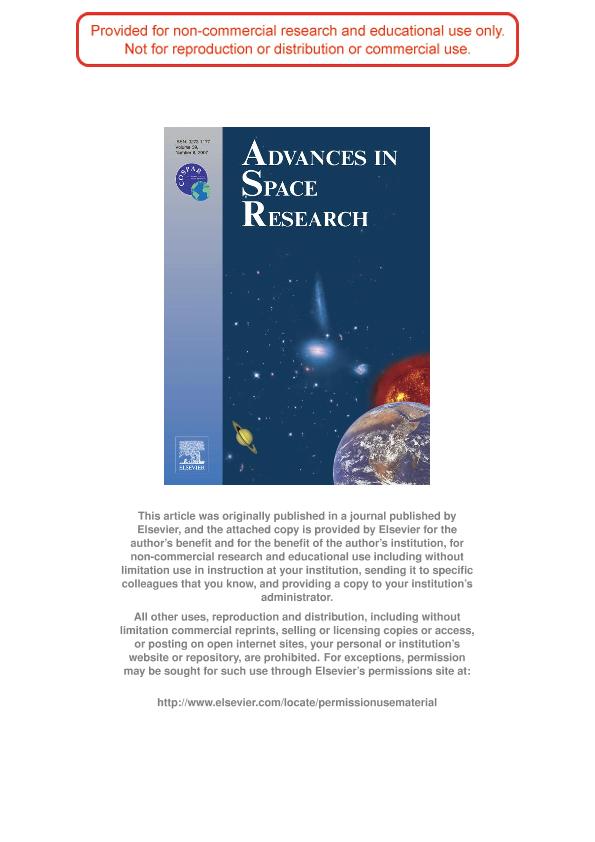Mostrar el registro sencillo del ítem
dc.contributor.author
Scheer, Jurgen

dc.contributor.author
Reisin, Esteban Rodolfo

dc.date.available
2017-08-04T20:19:19Z
dc.date.issued
2007-12
dc.identifier.citation
Scheer, Jurgen; Reisin, Esteban Rodolfo; Is there an influence of short-term solar activity variations on mesopause region airglow?; Elsevier; Advances in Space Research; 39; 8; 12-2007; 1248-1255
dc.identifier.issn
0273-1177
dc.identifier.uri
http://hdl.handle.net/11336/21913
dc.description.abstract
A-priori, rapid variations of solar activity that directly impact on the terrestrial environment should be expected to influence airglow brightness in the mesopause region via the photodissociative production of atomic oxygen, as it does on the time scale of the solar cycle. To find out whether this is supported by our midlatitude data, we analyze the strongest geoeffective solar activity events, in times when
data from the Argentine airglow spectrometer were obtained. An alternative interaction path involving geomagnetic perturbations mediated by the solar wind can also be expected to affect the mesopause region. Daily mean values of different solar and geomagnetic activity indices, and more than 1400 nights of airglow brightness and rotational temperature measurements (mostly from El Leoncito, 31.8S) are available for this study. The diagnostic value of this investigation is augmented by using information corresponding to two different nominal altitudes (87 km for the OH(6–2) band, and 95 km for the O2b(0–1) band). Our approach ranks the (solar and airglow) events by their respective strength, which automatically provides emphasis on the more important cases. We conclude that if an airglow response to strong solar events exists, it is only short-lived and should therefore most easily be detectable by daytime observations. On the other hand, we did not find signatures in our airglow data that could convincingly be related to geomagnetic storms.
dc.format
application/pdf
dc.language.iso
eng
dc.publisher
Elsevier

dc.rights
info:eu-repo/semantics/openAccess
dc.rights.uri
https://creativecommons.org/licenses/by-nc-sa/2.5/ar/
dc.subject
Airglow
dc.subject
Mesopause Region
dc.subject.classification
Astronomía

dc.subject.classification
Ciencias Físicas

dc.subject.classification
CIENCIAS NATURALES Y EXACTAS

dc.subject.classification
Oceanografía, Hidrología, Recursos Hídricos

dc.subject.classification
Ciencias de la Tierra y relacionadas con el Medio Ambiente

dc.subject.classification
CIENCIAS NATURALES Y EXACTAS

dc.title
Is there an influence of short-term solar activity variations on mesopause region airglow?
dc.type
info:eu-repo/semantics/article
dc.type
info:ar-repo/semantics/artículo
dc.type
info:eu-repo/semantics/publishedVersion
dc.date.updated
2017-08-04T15:43:48Z
dc.journal.volume
39
dc.journal.number
8
dc.journal.pagination
1248-1255
dc.journal.pais
Países Bajos

dc.journal.ciudad
Amsterdam
dc.description.fil
Fil: Scheer, Jurgen. Consejo Nacional de Investigaciónes Científicas y Técnicas. Oficina de Coordinación Administrativa Ciudad Universitaria. Instituto de Astronomía y Física del Espacio. - Universidad de Buenos Aires. Facultad de Ciencias Exactas y Naturales. Instituto de Astronomía y Física del Espacio; Argentina
dc.description.fil
Fil: Reisin, Esteban Rodolfo. Consejo Nacional de Investigaciónes Científicas y Técnicas. Oficina de Coordinación Administrativa Ciudad Universitaria. Instituto de Astronomía y Física del Espacio. - Universidad de Buenos Aires. Facultad de Ciencias Exactas y Naturales. Instituto de Astronomía y Física del Espacio; Argentina
dc.journal.title
Advances in Space Research

dc.relation.alternativeid
info:eu-repo/semantics/altIdentifier/doi/http://dx.doi.org/10.1016/j.asr.2007.01.002
dc.relation.alternativeid
info:eu-repo/semantics/altIdentifier/url/http://www.sciencedirect.com/science/article/pii/S0273117707000142
Archivos asociados
